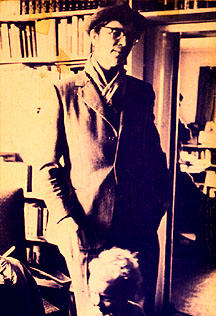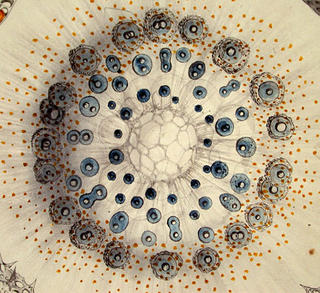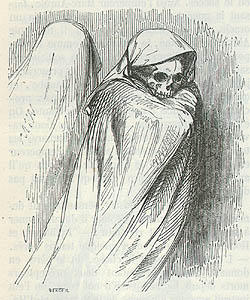
One of the authors that I used to seriously collect was Colin Wilson. At one point in my life, his books - especially the Outsider Series - were like maps, guiding me through unknown territories. I eagerly hunted down everything in and out of print. And in those dark pre-Amazon days, it was a real triumph of discovery to find a copy of the long out-of-print
Beyond the Outsider, signed by Wilson, on the dusty lower shelf in an old bookstore.
I am still a great fan of his work. I will admit that his prolific ventures through the fields of the occult and crime have left me somewhat cold. But I retain a great fondness for his earlier "philosophical" books and fiction. Consequently, I was a bit dismayed, slightly amused, to read the recent round of reviews for his latest book, the autobiography,
Dreaming to Some Purpose. In particular, the
non-review by Lynn Barber in The Guardian made me wince with its winking venom, reminding me of the initial backlash to
The Outsider and the rest of the Angry Young Men.
So I was delighted to have it brought to my attention (by the inimitable Jeff G.) that there has arisen something of a defense of Wilson and his work - in the New York Times, no less.
The full article has been reproduced below. However, before that, I have included an autobiographical review I wrote on
The Outsider several years ago for the now defunct Booklist.com site (which can be revisited via the Wayback Machine here:
http://web.archive.org/web/*/http://booklist.com):

I first encountered Wilson during my dreadful freshman year at Southern Methodist University in Dallas. A friend of mine from high school, Bill, who had wisely opted not to attend college, was working nearby at Taylor's Bookstore on Northwest Highway. Often I would stop by between, and sometimes during, classes to chat about what he was reading and see if anything interesting had come in.
One day Bill approached me as soon as I walked in the door, handed me a book, and told me to buy it and read it as soon as I could. High recommendation from someone as usually reticent towards praise as Bill. The book was
The Mind Parasites by Colin Wilson, published in an unusual style by Wingbow Press. On the back there was an intriguing quote from Wilson stating the novel should attack reality like an axe cutting into a tree. That was good enough for me. I purchased the book and read it as an excuse to skip classes for the rest of the day. Late that night, when I closed the covers of the book, I realized that something as yet indefinable, but significant, had changed in my perspective on the world.

I returned to Taylor's the next day to discover what other books had been written by Wilson. There were several on the occult, a companion to
The Mind Parasites called
The Philosopher's Stone and a work called
The Outsider. Of course I bought
The Philosopher's Stone and also picked up
The Outsider. Mid-way through
The Philosopher's Stone, I became so stimulated by the ideas and the possibilities, the I opened up
The Outsider to see if it explored the same issues.
I skipped past the Marilyn Ferguson foreword and the introduction by Wilson, to the first chapter, "The Country of the Blind". And from that first sentence, "At first sight, the Outsider is a social problem", and then, the quote from Barbusse ending with the line, "It is not a woman I want - it is all women, and I seek for them in those around me, one by one...", I was shot through with the hook, the line and the sinker for the "philosophy" of Colin Wilson. I finished
The Philosopher's Stone and began a deep reading of
The Outsider- neglecting most of my classes. When I did attend, it was as if I were participating in a surreal experiment of Outsiderism. What the professors were trying to teach me was utterly irrelevant to the life that was opening before me. And what my classmates wanted to discuss was even more banal and dead to me. I felt the "nausea" of Roquentin on an acute level, hours after having first read about it in The Outsider. And I came to the verge of recognizing that my college education was a complete sham when I got to chapter five, "The Pain Threshold" where Wilson cites the question by William James:
Does it not appear as if one who lived habitually on one side of the pain threshold might need a different sort of religion from one who habitually lived on the other?
For many years after,
The Outsider and the "outsider series" were guiding and teaching texts to me. I took it upon myself to read as many of the primary works referenced as I could. I soon dropped out of college and began what was to be a life of working in book stores. During this time, I carried around a paper inscribed with these "conclusions" by Wilson:
- The Outsider wants to cease to be an Outsider.
- He wants to be 'balanced'.
- He wants to achieve a vividness of sense-perception.
- He would also like to understand the human soul and its workings.
- He would like to escape triviality forever, and be 'possessed' by a Will to power, to more life.
- Above all, he would like to know how to express himself, because that is the means by which he can get to know himself and his unknown possibilities.
Below this, were the two discoveries about the Outsider's 'way':
- That his salvation 'lies in extremes'.
- That the idea of a way out often comes in 'visions', moments of intensity, etc.
The Outsider (and the "Outsider Series") was one of the first books directly responsible, in an extreme and literal sense, for vast changes in the manner in which I lived my life. It was not just that my perspective was altered, but that important life decisions were generated and nurtured under its influence. That a book could have such power was simply amazing to one who had been educated such as I had been. Since then, thankfully, there have been many "life changing" books for me.
Ross MacDonald once remarked that there are certain writers that once were the heart and soul of your direction, that one day you come to be able to "see around" them. (Shakespeare, he added, was one that you could never "see around".) To a certain extent, I can now "see around"
The Outsider - and not without a measure of sorrow. I still find myself returning to it often for "tuning". And I am still surprised when I dig into the roots of a current theme and discover what led me there initially, long ago, was a reference from
The Outsider.
Although the book was written nearly fifty years ago, it still retains much of its relevance. I understand that there is a peculiar folly in "backward thinking", but in many ways the issues that were of concern to the "intellectuals" of the 1950s are even more prevalent today. Of course, the questions of value and meaning of human existence are bound up in the nature of what defines consciousness. However, the problems of alienation of self in a society that is morally, intellectually and theologically bankrupt have never been more critical. Perhaps this is why that of all of Wilson's books,
The Outsider has been kept in print longer and more often than any other.
And, now, here is the NYT defense of Wilson that appeared August 17, 2005:
Philosopher of Optimism Endures Negative Deluge By Brad Spurgeon
Gorran Haven, Britain - Any intellectual who divides opinion as much as Colin Wilson has for almost 50 years must be onto something, even if it is only whether humans should be pessimistic or optimistic.
Mr. Wilson, who turned 74 in June and whose autobiography, "Dreaming to Some Purpose," recently appeared in paperback from Arrow, describes in the first chapter how he made his own choice. The son of working-class parents from Leicester - his father was in the boot and shoe trade - he was forced to quit school and go to work at 16, even though his ambition was to become "Einstein's successor." After a stint in a wool factory, he found a job as a laboratory assistant, but he was still in despair and decided to kill himself.
On the verge of swallowing hydrocyanic acid, he had an insight: there were two Colin Wilsons, one an idiotic, self-pitying teenager and the other a thinking man, his real self.
The idiot, he realized, would kill them both.
"In that moment," he wrote, "I glimpsed the marvelous, immense richness of reality, extending to distant horizons."
Achieving such moments of optimistic insight has been his goal and subject matter ever since, through more than 100 books, from his first success, "The Outsider," published in 1956, when he was declared a major existentialist thinker at 24, to the autobiography.
In an interview last month at his home of nearly 50 years on the Cornish coast, Mr. Wilson was as optimistic as ever, even though his autobiography and his life's work have come under strong attack in some quarters.
"What I wanted to do was to try to create a philosophy upon a completely new foundation," he said, sitting in his living room along with a parrot, two dogs and part of his collection of 30,000 books and as many records. "Whereas in the past optimism had been regarded as rather shallow - because 'oh well, it's just your temperament, you happen to be just a cheerful sort of person' - what I wanted to do was to establish that in fact it is the pessimists who are allowing all kinds of errors to creep into their work."
He includes in that category writers like Hemingway and philosophers like Sartre. In books on sex, crime, psychology and the occult, and in more than a dozen novels, Mr. Wilson has explored how pessimism can rob ordinary people of their powers.
"If you asked me what is the basis of all my work," he said, "it's the feeling there's something basically wrong with human beings. Human beings are like grandfather clocks driven by watch springs. Our powers appear to be taken away from us by something."
The critics, particularly in Britain, have alternately called him a genius and a fool. His autobiography, published in hardcover last year, has received mixed reviews. Though lauded by some, the attacks on it and Mr. Wilson have been as virulent as those he provoked in the 1950's after he became a popular culture name with the publication of "The Outsider."
That book dealt with alienation in thinkers, artists and men of action like T. E. Lawrence, van Gogh, Camus and Nietzsche, and caught the mood of the age. Critics, including Cyril Connolly and Philip Toynbee, hailed Mr. Wilson as a British version of the French existentialists.
His fans ranged from Muammar el-Qaddafi to Groucho Marx, who asked his British publisher to send a copy of his own autobiography to three people in Britain: Winston Churchill, Somerset Maugham and Colin Wilson.
"The Outsider" was translated into dozens of languages and sold millions of copies. It has never been out of print.
The Times of London called Mr. Wilson and John Osborne - another young working-class man, whose play "Look Back in Anger" opened about the same time "The Outsider" was published - "angry young men." That name was passed on to others of their generation, including Kingsley Amis, Alan Sillitoe and even Doris Lessing.
But fame brought its own problems for Wilson. His sometimes tumultuous early personal life became fodder for gossip columnists. He was still married to his first wife while living with his future second wife, Joy. His publisher, Victor Gollancz, urged him to leave the spotlight, and he and Joy moved to Cornwall.
But the publicity had done its damage. His second book, "Religion and the Rebel," was panned and his career looked dead.
Mr. Wilson said the episode had actually saved him as a writer, however. "Too much success gets you resting on your laurels and creates a kind of quicksand that you can't get out of," he said. "So I was relieved to get out of London."
He said his books were probably heading for condemnation in Britain anyway. "I'm basically a writer of ideas, and the English aren't interested in ideas," he said. "The English, I'm afraid, are totally brainless. If you're a writer of ideas like Sartre or Foucault or Derrida, then the general French public know your name, whereas here in England, their equivalent in the world of philosophy wouldn't be known."
He never lost belief in the importance of his work in trying to find out how to harness human beings' full powers and wipe out gloom.
"Sartre's 'man is a useless passion,' and Camus's feeling that life is absurd, and so on, basically meant that philosophy itself had turned really pretty dark," he said. "I could see that there was a basic fallacy in Sartre and Camus and all of these existentialists, Heidegger and so on. The basic fallacy lay in their failure to understand the actual foundation of the problem."
That foundation, he said, is that human perception is intentional; the pessimists themselves paint their world black.
Mr. Wilson has spent much of his life researching how to achieve those moments of well-being that bring insight, what the American psychologist Abraham Maslow called "peak experiences."
Those moments can come only through effort, concentration or focus, and refusing to lose one's vital energies through pessimism.
"What it means basically is that you're able to focus until you suddenly experience that sense that everything is good," Mr. Wilson said. "We go around leaking energy in the same way that someone who has slashed their wrists would go around leaking blood.
"Once you can actually get over that and recognize that this is not necessary, suddenly you begin to see the possibility of achieving a state of mind, a kind of steady focus, which means that you see things as extremely good." If harnessed by everyone, this could lead to the next step in human evolution, a kind of Superman.
"The problem with human beings so far is that they are met with so many setbacks that they are quite easily defeatable, particularly in the modern age when they've got too separated from their roots," he said.
Over the last year, he has been forced to test his own powers in this area. "When I was pretty sure that the autobiography was going to be a great success, and when it, on the contrary, got viciously attacked," Mr. Wilson said, "well, I know I'm not wrong. Obviously the times are out of joint."
Though "Dreaming to Some Purpose" was warmly received in The Independent on Sunday and The Spectator and was praised by the novelist Philip Pullman, the autobiography - and Mr. Wilson - received a barrage of negative profiles and reviews in The Sunday Times and The Observer. These made fun of the book's more eccentric parts, like his avowed fetish for women's panties.
As a measure of the passions that Mr. Wilson provokes, Robert Meadley, an essayist, wrote "The Odyssey of a Dogged Optimist" (Savoy, 2004), a 188-page book defending him.
"If you think a man's a fool and his books are a waste of time, how long does it take to say so?" Mr. Meadley wrote, questioning the space the newspapers gave to the attacks.
Part of Mr. Meadley's conclusion is that the British intellectual establishment still felt threatened by Mr. Wilson, a self-educated outsider from the working class.
"One of my main problems as far as the public is concerned is that I've always been interested in too many things," Mr. Wilson said, "and if they can't typecast you as a writer on this or that, then I'm afraid you tend not to be understood at all."
See also:
The Biography Project: Colin WilsonThe Colin Wilson PageLycaeum: Colin Wilson InterviewColin Wilson: Psychological Ideas about Human PotentialThe High and Low with Colin Wilson




















